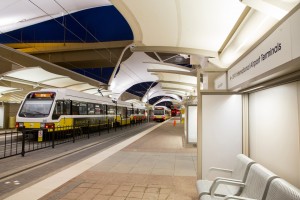All about the community of model railroading and rail enthusiasm
July 10, 2014
From staff reports and news releases
Dallas Area Rapid Transit got a little closer to starting service to Dallas/Fort Worth International Airport on Tuesday when a select group of passengers got a sneak preview of the new Orange Line extension to Terminal A. A special train that reached speeds of more than 60 mph whisked into the new D/FW Airport station filled with dignitaries and media, signaling the countdown to an Aug. 18 opening of revenue service. We’re all going to need to use something like an airport car service to reach this train on time.

When open in August, Dallas Area Rapid Transit’s rail station at Terminal A at D/FW International Airport will connect Downtown Dallas to the nation’s third largest airport. – Courtesy DART
When open, the five-mile Orange Line extension from Belt Line Station in Irving is expected to eventually move about 1,200 flyers and employees daily into the airport. Riders from Downtown Dallas will have a direct link to the D/FW Airport, which will become the third-largest American airport with a direct rail connection to a city center.
D/FW Airport built the station as part of its construction at Terminal A, the first of the legacy terminals to be renovated. Service is expected to start four months ahead of schedule and under budget.
“We could not have achieved this rail opening early and under budget without the incredible partnership with DFW Airport,” DART President/Executive Director Gary Thomas said. “Construction of the station and the Orange Line extension has been a true collaboration.”
DART’s arrival comes at time as the airport is growing its roster of international and domestic destinations and when metropolitan cities are making light-rail connectivity to airports a priority.
Dallas/Fort Worth will come off a short list of major airports that include Denver, Los Angeles, Charlotte and Las Vegas that see more than 40 million passengers per year, but lack rail service to their downtown areas. However, other cities are making strides to connect train riders with airplanes.
Salt Lake City, Phoenix and Miami most recently began light-rail service to their airports. Soon after DART starts running trains, service openings are expected to follow in Oakland, Denver and Orlando.
Regional Transportation District of Denver will open its new East Line to Denver International Airport in 2016. Construction began in 2010 to extend the line 22.8 miles from Union Station in downtown to DIA.
“Every renowned, world-class airport has rail service to the city center,” said Sean Donohue, CEO of Dallas/Fort Worth International Airport. “One of our key priorities is to continue to grow globally and add more international service, so to be able to provide that same access to our customers is fantastic.”
Regional leaders believe that light rail service from the airport to the rest of the DART service area will help attract everything from corporations to conferences. Also, the connection will enable a transportation alternative to nearly 60,000 people who work at the airport.
“Employees, as well as employers, really value this connectivity and it will make it possible for employers to grow their operations and their employee talent pool, and that’s a good thing for the airport,” Donohue said.
Early morning and late night trains will roll in and out of the station on a daily basis. The first Orange Line train departing downtown Dallas will arrive at D/FW Airport Station at 3:50 a.m. The last train departs D/FW Airport for downtown at 1:12 a.m. weekdays; 12:12 a.m. weekends.